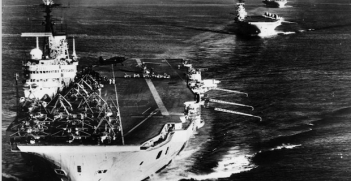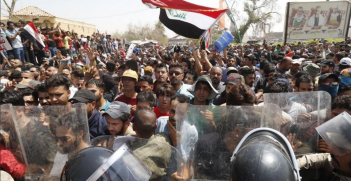The Iran-China Strategic Partnership and Changing Regional Order
The Sino-Iranian Comprehensive Strategic Partnership is another move by Beijing to extend its power across the globe. For Iran, it is about further strengthening the country’s position in the Middle East.
The emerging international architecture of world politics is characterised by the rise of new regional powers and greater intraregional interactions across the globe. The power struggle between the existing super-power (the United States), the “great powers” (China, EU, Russia), and regional powers (Iran, India, Brazil, South Africa) is transforming the overall dynamic of global international relations. The rapid emergence of new global powers and nascent regional leaders is serving to constantly challenge US global hegemony and hamper its claim to leadership on the world stage. The altered architecture of world politics, characterised by growing regionalism, indicates that the rising role of the region is reshaping international order.
In an emerging new international system, China is asserting its political and security interests further afield. China’s surging economic power has inevitably prompted shifts in its own region into a Sino-centric Asian order, with Asia (and specifically the Asia-Pacific region) becoming a deeply politicised and securitised arena of Chinese foreign policy interests. The signing of the recent comprehensive strategic partnership with Iran, however, indicates that Beijing is moving its strategic ambitions well beyond East Asia into the most geostrategically important region in the world: the Middle East.
The new regional security complex of the Middle East, characterised by a rise in the prevalence of weak states, the emergence of crucial non-state actors, the re-emergence of power vacuums, increasing insecurity, and increasingly identity-based conflicts, has allowed Tehran to fill in power gaps by mobilising Shi’a armed groups across the region. Via the funding and support of insurgent Shi’a groups and Shi’a political entities, Iran has been able to achieve more of its political ends and confront the US presence in the region. Tehran has also further developed its nuclear programme and its military power, particularly its missile and drone technologies.
China constitutes an emergent great power with the potential to dramatically reduce US hegemony, so Iran, as a regional power, has sought to exploit and utilise this potential to challenge US influence and isolate the US presence in the Middle East and beyond. This strategic partnership has ultimately been formed to confront the regional monopolisation headed by the US and to concomitantly counter US global hegemony. What distinguishes the Sino-Iranian partnership from other partnerships that China has secured with others in the Middle East is its broader-reaching counter-hegemonic nature.
Mirroring the US international policy approach of establishing core states in different regions to maintain its influence (e.g. Japan in Asia, the United Kingdom in Europe), China aims to expand its influence and grow its geostrategic significance by positioning Iran as its core state partner in the Middle East. This partnership is particularly important since the region is witnessing a marked decline in US soft power. The US is also reluctant to physically engage with serious security threats and is evidently reducing its military presence in the region. The Sino-Iranian partnership, in the long term, will act to challenge US hegemony in the region, potentially leading to a post-America Middle Eastern dynamic.
Tehran has experienced tremendous economic strain due to the maximum pressure policy initiated by President Trump, designed to force Iran to surrender to US terms and conditions. This policy has failed to achieve its objectives. It has, indeed, brought Iran closer to acquisition of the nuclear bomb and closer to China. The contentious policy of placing immense pressure on Iran has in fact resulted in a greater divide between Iran and the US, prompting Tehran to adopt two game-changer strategies to enhance its bargaining power and to ensure regime survival.
Firstly, the maximum pressure policy has pushed Tehran to form this strategic partnership with China to ensure it will survive economically. China’s appetite to gain greater influence in the Middle East is also satiated through Iranian cooperation. In this, an age of intensified US-China rivalry, and in an increasingly multi-polar international order, Iran comprises a critical regional actor through which China may be able to viably tilt the balance of power in the foreseeable future. The oil and gas resources of Iran also comprise valuable means for China to boost its power both in the region and at home. Crucial to China’s Belt and Road Initiative, Iran is geo-strategically located in the centre of China’s connections to Europe and the Mediterranean, and in a critical position vis-à-vis Central Asia and South Asia. Oversight of the Persian Gulf region by a Sino-friendly Iran will hence be an integral component of the Belt and Road Initiative. The Sino-Iranian partnership will also undermine the interests and power of India, China’s major regional Asian rival, in the Middle East.
Secondly, the maximum pressure policy has also driven Tehran to advance both its overt and its clandestine nuclear activities. These are intended to enhance the state’s bargaining power in the diplomatic marathon with the West over its nuclear ambitions. Should diplomacy fail to meet Tehran’s demands, Tehran will be relatively closer to making the bomb and thus capable of enacting nuclear deterrence. Currently, it would take Iran just a few months, if not weeks, to produce enough materials for a single nuclear weapon. The nuclear empowerment of Iran would not only guarantee its survival, but would also permanently change the security architecture and balance of power in the Middle East as a whole.
Iran, for its part, has been attempting to balance its pursuit of interests with the West and the East, but this balance is tilting and Iran is siding with China. Such a substantive partnership serves Tehran economically, politically, and in terms of security. China will invest in strategic ports in Iran, as well as railways and transport infrastructure. Crucially, it will also invest and exchange knowledge in Iran’s military technology.
The 25-year strategic partnership between Beijing and Tehran symbolises, and now launches into practice, a provisional but growing challenge to US dominance in the region. The US cannot afford to cede to China’s efforts to increase its influence and presence in critical regions such as the Middle East.
Washington is attempting to use regional allies as proxy mechanisms to deal with regional security issues, assigning itself the more remote roles of surveillance monitor and observer. To contain Iran, Israel and Saudi Arabia are utilised as regional checks on Tehran’s ambitions in the Middle East. Sudden changes in regional dynamics prompted by the involvement of great powers like China or Russia may, however, affect change in the balance of power, limiting US influence and impeding US strategy.
Trump’s withdrawal from the nuclear deal, the imposition of maximum pressure on Iran, and the EU’s failure to help Iran restore its economy have together wreaked severe damage to the already worrying trust-gap between Iran and the West. Tehran, consequently, has lost hope in a solely West-facing strategy, and “those who have no hope and nothing to lose will always be dangerous.” Tehran is for now happy to play the role of a balancing mechanism, hedging its bets amidst the conflicts between the West and the East. Yet this may change, should Washington further push it towards Beijing, or indeed Moscow.
Alam Saleh is a lecturer in Politics and International Relations (Iran and The Middle East) at the Centre for Arab and Islamic Studies, Australian National University. He is also a council member of the British Society for Middle Eastern Studies.
This article is published under a Creative Commons License and may be republished with attribution.





